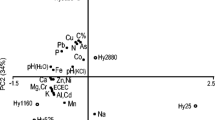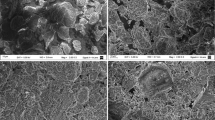Abstract
The horizons of four natural soils were treated with Cu2+ in an acid medium to study the retention capacity of Cu. The possible mineralogical changes arising because of the treatment were also studied. The soil properties and characteristics with the greatest influence on the metal retention and its distribution among the different soil fractions were determined. Crystalline phases of each horizon were determined by X-ray diffraction (XDR). The morphology, structural distribution and particle chemical composition of soil samples were investigated using field emission scanning electron microscopy. Cu distribution in the different geochemical phases of the soil was studied using a sequential extraction. The treatment led to an increase in the amorphous phases and the formation of new crystalline phases, such as rouaite (Cu2(NO3)(OH)3) and nitratine (NaNO3). Cu was also found superficially sorbed on amorphous hydroxy compounds of Fe that interact with albite, muscovite and gibbsite, and also on spherical and curved particles of aluminium clays. The largest amount of Cu retained was in an exchangeable form, and the smallest amount associated with the crystalline Fe oxides and residual fraction. In the surface horizons, the predominant Cu retention process is complexation in organomineral associations, while in the subsurface horizons it is adsorption.



Similar content being viewed by others
References
Agbenin JO, Olojo LA (2004) Competitive adsorption of copper and zinc by a Bt horizon of a savanna alfisol as affected by pH and selective removal of hydrous oxides and organic matter. Geoderma 119:85–95
Andrade L, Alonso Vega F, Marcet P, Fernández Covelo E (2005) Heavy metal contents of soils from semiarid Pampa, Buenos Aires Province (Argentina). In: Faz Cano A et al. (ed) Sustainable use and management of soils-arid and semiarid regions. Soil contamination and remediation. Advances in Geoecology. Germany: A Cooperatting Series in the International Union of Soil Science, pp 477-492
Banerjee ADK (2003) Heavy metal levels and solid phase speciation in street dusts of Delhi, India. Environ Pollut 123(1):95–105
Beesley L, Marmiroli M (2011) The immobilisation and retention of soluble arsenic, cadmium and zinc by biochar. Environ Pollut 159:474–480
Borchard N, Prost K, Kautz T, Moeller A, Siemens J (2012) Sorption of copper(II) and sulphate to different biochars before and after composting with farmyard manure. Eur J Soil Sci 63:399–409
Bradl HB (2004) Adsorption of heavy metal ions on soils and soils constituents. J Colloid Interface Sci 277:1–18
Buol SW (2006) Pedogenic processes and pathways of horizon differentiation. In: Certini G, Scalenghe R (eds) Soils basic concepts and future challenges. Cambridge University Press, Cambridge, pp 11–21
Negra C, Ross DS, Lanzirotti A (2005) Soil manganese oxides and trace metals: competitive sorption and microfocused synchtron X-ray fluorescence mapping. Soil Sci Soc Am J 69:353–361
Cao J, Lam KC, Dawson RW, Liu WX, Tao S (2004) The effect of pH, ion strength and reactant content on the complexation of Cu2+ by various natural organic ligands from water and soil in Hong Kong. Chemosphere 54(4):507–514
Cerqueira B, Covelo EF, Andrade ML, Vega FA (2011) The influence of soil properties on the individual and competitive sorption and desorption of Cu and Cd. Geoderma 162:20–26
Cerqueira B, Vega FA, Silva LFO, Andrade L (2012) Effects of vegetation on chemical and mineralogical characteristics of soils developed on a decantation bank from a copper mine. Sci Total Environ 421–422:220–229
Chao TT, Zhou L (1983) Extraction techniques for selective dissolution of amorphous iron oxides from soils and sediments. Soil Sci Soc Am J 47:225–232
Chung FH (1974) Quantitative interpretation of X-ray diffraction patterns. I. Matrix-flushing method of quantitative multicomponent analysis. J Appl Crystallogr 7:519–525
Covelo EF, Vega FA, Andrade ML (2007) Competitive sorption and desorption of heavy metals by individual soil components. J Hazard Mater 140:308–315
Day PR (1965) Particle fractionation and particle-size analysis. In: Black CA (ed) Methods of soil analysis, Part 1. American Society of Agronomy, Madison, pp 545–567
Fabrizio de Iorio A (2010) Sorption capacity of Cu and Zn in natraquols of depressed Pampa (Argentina). Relationship with geochemical phases (in Spanish). Ph.D. Thesis, University of Vigo
FAO (2006) World reference base for soil resources. In: IUSS (ed) ISRIC, Rome
Guitián F, Carballas T (1976) Techniques of soil analysis (in Spanish). Pico Sacro, Santiago de Compostela
He ZL, Yang XE, Stoffella PJ (2005) Trace elements in agroecosystems and impacts on the environment. J Trace Elem Med Biol 19:125–140
Hendershot WH, Duquette M (1986) A simple barium chloride method for determining cation exchange capacity and exchangeable cations. Soil Sci Soc Am J 50:605–608
Hutchins C, Teasdale PR, Lee SY, Simpson SL (2007) Effect of manipulating sediment pH on the porewater chemistry of copper- and zinc-spiked sediments. Chemosphere 69:1089–1099
Hutchins C, Teasdale PR, Lee SY, Simpson SL (2009) Effect of sediment type and pH-adjustment on the porewater chemistry of copper- and zinc- spiked sediments. Soil Sediment Contam 18:55–73
ICDD. International Center for Diffraction Data (2014) http://www.icdd.com. Accessed 2014
Jackson BP, Miller WP (2000) Effectiveness of phosphate and hydroxide for desorption of arsenic and selenium species from iron oxides. Soil Sci Soc Am J 64:1616–1622
Kabala C, Singh BR (2001) Fractionation and mobility of copper, lead, and zinc in soil profiles in the vicinity of a copper smelter. J Environ Qual 30(2):485–492
Kabata-Pendias A (2001) Trace elements in soils and plants. CRC Press, Boca Raton, FL
Li W, Zhang M, Shu H (2005) Distribution and fractionation of copper in soils of apple orchards. Environ Sci Pollut Res 12(3):168–172
Li Q, Wu Z, Chu B, Zhang N, Cai S, Fang J (2007) Heavy metals in coastal wetland sediments of the pearl river estuary, China. Environ Pollut 149(2):158–164
Ma LQ, Rao GN (1997) Chemical fractionation of cadmium, copper, nickel, and zinc in contaminated soils. J Environ Qual 26(1):259–264
Moon DH, Cheong KH, Khim J, Grubb DG, Ko I (2011) Stabilization of Cu-contaminated army firing range soils using waste oyster shells. Environ Geochem Health 33(1):159–166
Németh T, Sipos P, Balázs R, Szalai Z, Mészáros E, Di Gléria M (2010) Adsorption of copper on the illuviation and accumulation horizons of a Luvisol. Carpath J Earth Environ 5:19–24
Qin F, Shan X, Wei B (2004) Effects of low-molecular-weight organic acids and residence time on desorption of Cu, Cd, and Pb from soils. Chemosphere 57:253–263
Roy S, Bhattacharyya P, Ghosh AK (2004) Influence of toxic heavy metals on activity of acid and alkaline phosphatase enzymes in metal contaminated landfill soils. Aust J Soil Res 42:339–344
Sherdrick BH, McKeague JA (1975) A comparison of extractable Fe and Al data using methods followed in the U.S.A. and Canada. Can J Chem 55:77–78
Shuman LM (1979) Zinc, manganese and copper in soil fractions. Soil Sci 127:10–17
Shuman LM (1985) Fractionation method for soil microelements. Soil Sci 140:11–22
Silva LFO, Da Boit KM (2011) Nanominerals and nanoparticles in feed coal and bottom ash: implications for human health effects. Environ Monit Assess 174:187–197
Silva LFO, Hower JC, Izquierdo M, Querol X (2010a) Complex nanominerals and ultrafine particles assemblages in phosphogypsum of the fertilizer industry and implications on human exposure. Sci Total Environ 408:5117–5122
Silva LFO, Ward CR, Hower JC, Izquierdo M, Waanders F, Oliveira MLS, Li Z, Hatch RS, Xavier Q (2010b) Mineralogy and leaching characteristics of coal ash from a major Brazilian power plant. CCGP 2:51–65
Silva LFO, Wollenschlager M, Oliveira MLS (2011) A preliminary study of coal mining drainage and environmental health in the Santa Catarina region, Brazil. Environ Geochem Health 33:55–65
Soil Conservation Service, U.S. Department of Agriculture (1972) Soil survey laboratory methods and procedures for collecting soil samples. Soil Survey Investigations Report No. 1 (revised). Government Printing Office, Washington DC
Srinivasa Gowd S, Ramakrishna Reddy M, Govil PK (2010) Assessment of heavy metal contamination in soils at Jajmau (Kanpur) and Unnao industrial areas of the Ganga Plain, Uttar Pradesh, India. J Hazard Mater 174(1–3):113–121
Su DC, Wong JWC (2004) Chemical speciation and phytoavailability of Zn, Cu, Ni and Cd in soil amended with fly ash-stabilized sewage sludge. Environ Int 29(7):895–900
Tomura S, Shibasaki Y, Mizuta H, Kitamura M (1985) Growth conditions and genesis of spherical and platy kaolinite. Clays Clay Minerals 33:200–206
Vega FA, Andrade ML, Covelo EF (2010) Influence of soil properties on the sorption and retention of cadmium, copper and lead, separately and together, by 20 soil horizons: comparison of linear regression and tree regression analyses. J Hazard Mater 174:522–533
Vega FA, Covelo EF, Andrade L (2009) The role of cation exchange in the sorption of cadmium, copper and lead by soils saturated with magnesium. J Hazard Mater 171:262–267
Violante A, Cozzolino V, Perelomov L, Caporale AG, Pigna M (2010) Mobility and bioavailability of heavy metals and metalloids in soil environments. J Soil Sci Plant Nutr 10(3):268–292
Wei B, Yang L (2010) A review of heavy metal contaminations in urban soils, urban road dusts and agricultural soils from China. Microchem J 94:99–107
Xue H, Nhat PH, Gächter R, Hooda PS (2003) The transport of Cu and Zn from agricultural soils to surface water in a small catchment. Adv Environ Res 8:69–76
Yang Z, Lu W, Long Y, Bao X, Yang Q (2011) Assessment of heavy metals contamination in urban topsoil from Changchun City, China. J Geochem Explor 108(1):27–38
Yu S, He ZL, Huang CY, Chen GC, Calvert DV (2004) Copper fractionation and extractability in two contaminated variable charge soils. Geoderma 123:163–175
Yu X, Yan Y, Wang W (2010) The distribution and speciation of trace metals in surface sediments from the Pearl River Estuary and the Daya Bay, Southern China. Mar Pollut Bull 60:1364–1371
Zhang M, Alva AK, Li YC, Calvert DV (1997) Chemical association of Cu, Zn, Mn, and Pb in selected sandy citrus soils. Soil Sci 162(3):181–188
Zhou D, Chen H, Hao X, Wang Y (2002) Fractionation of heavy metals in soils as affected by soil types and metal load quantity. Pedosphere 12:309–319
Zhuang P, McBride MB, Xia H, Li N, Li Z (2009) Health risk from heavy metals via consumption of food crops in the vicinity of Dabaoshan mine, South China. Sci Total Environ 407(5):1551–156
Acknowledgments
This study was supported by the Xunta de Galicia (project EM2013/018). We also thank the Spanish Ministry of Education and Science due to the Ramón y Cajal contract awarded to F.A. Vega. D. Arenas Lago was also awarded with a pre-doctoral fellowship FPI-MICINN.
Author information
Authors and Affiliations
Corresponding author
Additional information
Responsible editor: Stuart Simpson
Rights and permissions
About this article
Cite this article
Arenas-Lago, D., Vega, F.A., Silva, L.F.O. et al. Copper distribution in surface and subsurface soil horizons. Environ Sci Pollut Res 21, 10997–11008 (2014). https://doi.org/10.1007/s11356-014-3084-4
Received:
Accepted:
Published:
Issue Date:
DOI: https://doi.org/10.1007/s11356-014-3084-4




